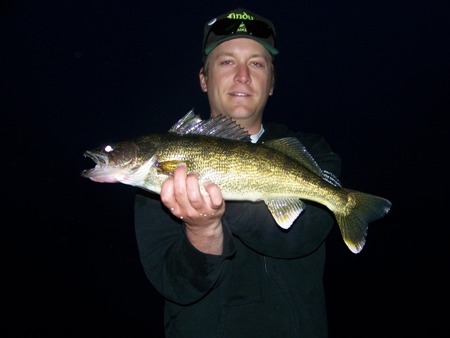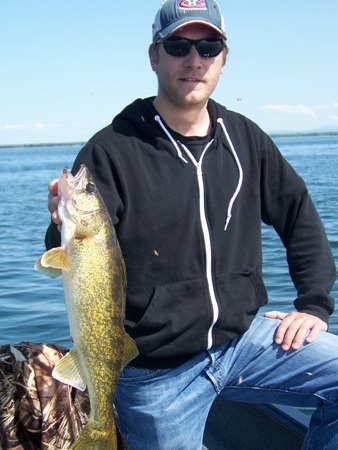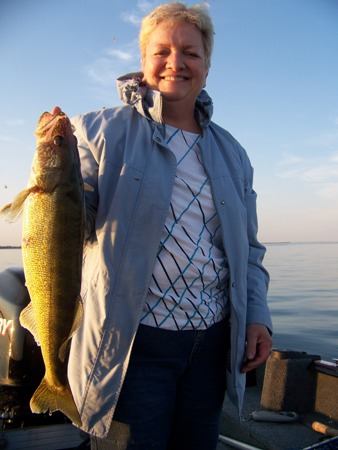Ok so the fans didn’t appreciate my birdbrain story. I’ll admit it was quite different. But hey, it’s my blog and I felt like trying something new. 🙂 Now let’s get back to fishing.
It’s been a strangely cold June and early July so far as most of you are aware, but the fishing has been decent. I had to chance to fish with my old friend Donald twice in June and luckily the fish were cooperative. I was able to put Donald onto his personal best walleye and we did quite well numbers-wise also. We caught most of our fish on channel rockpiles but this larger one lingered in shallow spawning waters. I have caught larger fish returning from their spawning run a few times quite late in the season  when most anglers have moved over to the deeper summer structure. When the fishing slows on the big lake in late June sometimes it really pays to take a look to the shallows to see if you can find a lingering fish; particularly late in the day. I assume these are female fish who took a longer time to recuperate after spawning, hence them usually being at or better than the 5lbs mark. They stay in shallow water longer than most people, myself included think. Either that or they migrate in and out of there. I know walleyes move a lot and this is also possible. Point is, don’t give up on the shallows two weeks into the season. Fish will stay there into water temps nearing 70.
Â
I really enjoy finding new spots and having a chartplotter immediately made me a better angler. It allows you to pinpoint your boat location on structure instead of relying on maps and visual reference points like islands for example. It’s a tremendous advantage because you can fish new areas without the need to explore them first. You can understand the piece of structure you are fishing without seeing it and you can be absolutely sure you are in the right spot. Walleyes really like rock. That’s no secret. Thing is, finding rocks in deep water on lake St-Francis can be a real challenge. There are cues on the surface that you can use if you don’t have a chartplotter. You’ll notice rock piles create a distinct effect on the surface in current. As the current hits a rock pile the water gets rushed to the surface and creates a small noticeable backwash on the surface. The presence of these on the water surface often indicate that something is going on on the bottom and they usually mean that you are on good walleye holding structure.
Once you have found these pieces of structure it’s a matter of presentation. This can get tricky on lake St-Francis for two reasons. First you have the water clarity problem. It’s no secret that the zebra mussel invasion has greatly cleared up the waters of the Great Lakes and St-Lawence. I remember as a kid that the water was always slightly coloured and now we see bottom in 20 feet of water or more in certain cases. The solution to this problem for me has been the use of fluorocarbon leaders on all my applications. Learn to tie a uni to uni knot and you’re all set. I’ve never had a uni to uni knot slip on me and I use it with Fireline and other super braids. Fluorocarbon is tougher than mono, more abbrasion resistant which is a huge plus when fishing rocks, and it is virtually invisible under water. This allows me to use a heavier pound test leader than I would using mono. Second you have the current. Some guys are really good at presenting jigs in current on top of structure. It’s not one of my fortes so I usually prefer to troll although you will catch lots of fish on jigs. I was fishing a spot with two other boats and had a little chat with a guy who was jigging so violently it looked like he was trying to chop wood or something. I caught 3 walleyes for his 8 that night. “They like it North South” he said to me. Regardless of the way you choose to target the fish you need to be on (or near) bottom so prepare to use heavy sinkers and you can expect your wrist to feel like it’s going to fall off at the end of the day. However the reward is definitely worth the pain, as my mother will confirm. This very nice fish, her personal best, was patroling a rock pile and didn’t hesitate to eat. When the fish are on top of the rock pile as opposed to the edges of them you can assume they are there to eat. They hover over the rocks in search of forage. If you spot arches on your sonar over deep rock piles indicating that the fish are about 2 feet off bottom it’s a safe bet they are on the feed and you can catch them. If the fish are hugging bottom on the sides or behind rock piles they may be tougher to coax into biting.
As always the fishing slows after about 1 or 2pm until the sun lowers after dinner. It pays off to try your luck at dusk if you’ve had a tough day. The fish definitely become more aggressive as light dims even into complete darkness. Fishing late in the day can also allow you to witness spectacular sunsets and there is a good chance you’ll be the only one on the water. Well, other than me that is.
value=”http://www.youtube.com/v/bHKNYrnrf7M&hl=en&fs=1″>
Stay Outside! Jigger.



